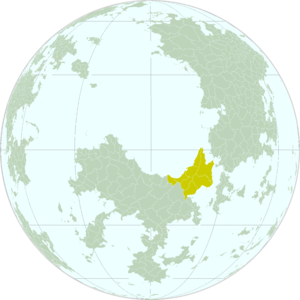Chaska: Difference between revisions
No edit summary |
No edit summary |
||
| Line 19: | Line 19: | ||
! style="background-color: #BDBDBD;"! colspan="2" | '''Locator map''' | ! style="background-color: #BDBDBD;"! colspan="2" | '''Locator map''' | ||
|- | |- | ||
! style="text-align: center;"! colspan="2" |[[File:Chaska.png|thumb | ! style="text-align: center;"! colspan="2" |[[File:Chaska.png|thumb]] | ||
|- | |- | ||
! Capital city | ! Capital city | ||
Revision as of 00:07, 18 September 2023
| Chaska | |
| Flag | Coat of arms |
|---|---|
| File:Missingflag.png | 
|
| Motto: Mana Qonqasunchikchutaq
"Nevertheless, we will not forget" | |
| Anthem: The War Song | |
| Locator map | |
 | |
| Capital city | Qheca |
| Largest city | |
| Official language | Remana |
| Other languages | |
| Ethnic groups | Ruma |
| Religion | Circulism |
| Demonym(s) | Chaskan |
| Government | |
| Government Type | Government type |
| Your 1st leader title (e.g. King) | name |
| Uma Akllaxqa (Premier) | name |
| Legislature | your choice |
| Establishment | |
| The Founding of Qheca | date 1 |
| The Quiet Revolution | date 2 |
| Area | |
| Total | 1,983,088.96 km2 |
| Water % | 0.0% |
| Population | |
| Total | 85,219,877 |
| Density | 42.97/km2 |
| Economy | |
| Economy type | |
| GDP (total) | Ꞡ 525,506,341,492.37 |
| GDP per capita | Ꞡ 6,166.48 |
| Currency | samp_nat_currency |
| Currency symbol | |
| Inequality index | 0.0 |
| Development index | 0.0 |
| Other information | |
| Time zone | 0 |
| Driving side | right |
| Calling code | +441 |
| Internet code | .ch |
Chaska is a reasonably large, reasonably populated nation just to the south of the equator. It is most prominently known for its history (once part of three separate empires simultaneously), its reserves of gold and coal and plantations of coffee, its architecture, and its music.
Chaska used to be the eastern provinces of Huilcasonco, an empire spanning the Kancha and Suyana Mountain ranges and much of their associated lowlands on either side. Once divided, it then survived in the form of Ayawantin, an independent state in the southern lowlands which expanded out to the islands in the east while the mountains became the territory of colonial states. It was only after the Quiet Revolution that the two were reunited once again into the state occupying its present borders, although they were obliged to forfeit the island territory they had since gained.
Today, Chaska is divided into the northern regions—industrial, more than slightly Livaryan in look and manner, whose wealth comes from the provision of power through thermal generators on the mountain coastline—and the southern regions—less industrialized and more traditionalist (they call themselves ñach'uq "authentic, pure"), whose main wealth comes from trade and the plantations of coffee and spices found in the lowlands.